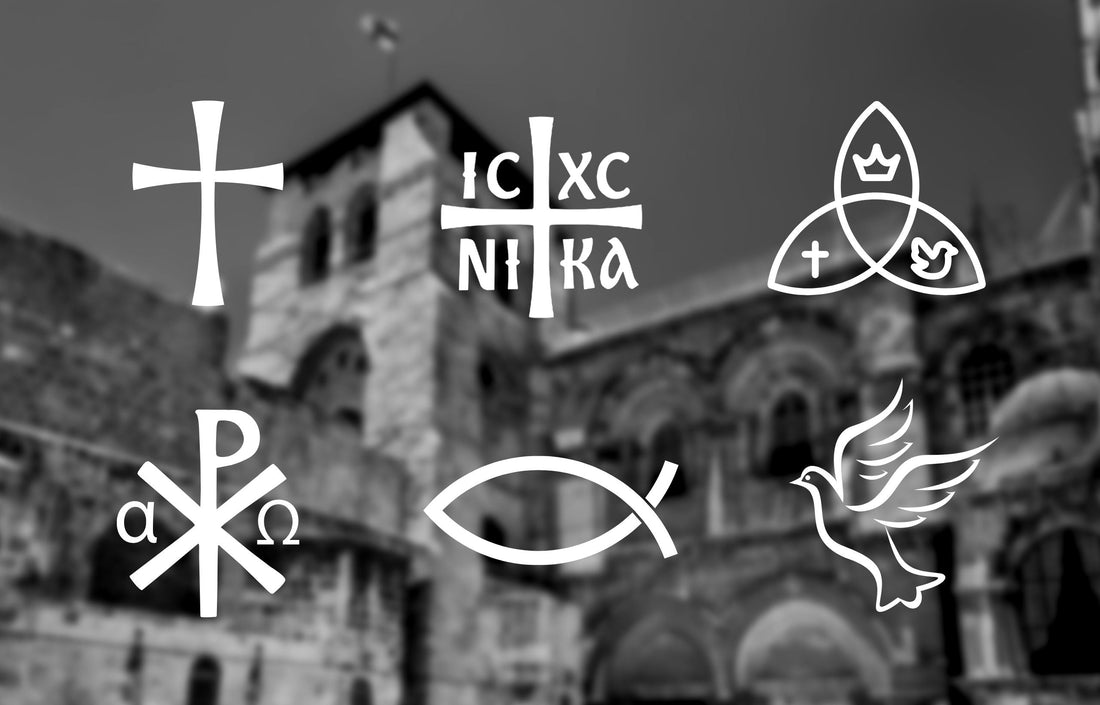Table of content
- 1. Trinity & Theological Symbols
- 2. Christological Symbols
- 3. Symbols of the Holy Spirit
- 4. Cross Variations
- 5. Early Christian Symbols
- 6. Biblical Symbols
- 7. Eucharistic & Liturgical Symbols
- 8. Marian Symbols
- 9. Saints & Ecclesiastical Symbols
- 10. Eschatological & Resurrection Symbols
- Symbolism of Numbers in the Bible
- Misunderstood Christian Symbols
- Conclusion: Symbols That Speak Faith
Religious symbols of christianity convey profound theological truths through imagery, many rooted in Scripture and early church history. Over 2.3 billion Christians worldwide recognize the cross (Matt. 16:24) as the central symbol of redemption.
A 2018 study from the Journal of Religion and Health found that visual religious cues increased personal reflection and daily spiritual engagement by 37%. Theologian Miroslav Volf once said, "Faith is not a private language." Symbols help make it public.
1. Trinity & Theological Symbols
These religion symbols visually represent the central doctrine of the Holy Trinity – Father, Son, and Holy Spirit – as well as other fundamental theological concepts within Christianity.

Triquetra (Trinity Knot)
Meaning & Significance: The Triquetra symbolizes the Holy Trinity—Father, Son, and Holy Spirit—three distinct yet unified persons in one divine essence. Its continuous, interwoven design reflects eternity, unity, and the inseparable nature of God’s triune being.

History & Origin
With roots in ancient Celtic and Germanic art, the Triquetra was adopted by early Christians to express the mystery of the Trinity in a visual, culturally resonant form. It often appeared in illuminated manuscripts like the Book of Kells and on high crosses across Ireland and Britain.
Where It Appears
Found in Celtic crosses, Christian jewelry, stained glass, and liturgical decor. It’s often used in modern Christian art and design to communicate the depth and mystery of the Trinity with elegant simplicity.
Baptizing them in the name of the Father and of the Son and of the Holy Spirit.
Shield of the Trinity
Meaning & Significance: The Shield of the Trinity is a visual diagram that illustrates the complex doctrine of the Trinity. It affirms that the Father, Son, and Holy Spirit are each fully God, distinct from one another, yet united in one divine essence—God is three in one, not three gods.

History & Origin
Dating back to medieval times, the diagram (Latin: Scutum Fidei) was used in Christian theology and education to explain the Trinity’s logic and defend orthodox belief. It became a popular teaching tool and was often inscribed in churches, manuscripts, and theological texts.
Where It Appears
Found in cathedrals, creeds, and catechisms, especially within Western Christianity. Today, it’s used in Christian education, apologetics, and artwork to symbolize the profound unity and mystery of the triune God.
Jesus' baptism shows the Father, Son, and Spirit present together.
All-Seeing Eye (Divine Providence)
Meaning & Significance: The All-Seeing Eye symbolizes God's omniscience—His ability to see all things, including the thoughts and hearts of humanity. It represents divine watchfulness, providence, and the assurance that nothing escapes God’s notice.

History & Origin
Though it predates Christianity in various cultures, the symbol was adopted by Christian artists during the Renaissance. Often enclosed in a triangle (to signify the Trinity) and surrounded by rays of light, it became a common symbol of God’s all-knowing presence—especially in church art and iconography.
Where It Appears
Seen in stained glass windows, church ceilings, and Christian architecture—especially above altars or domes. Sometimes confused with secular or conspiracy symbolism, its original intent is deeply theological: God sees, knows, and cares.
The eyes of the Lord are in every place, keeping watch on the evil and the good.
The Shamrock
Meaning & Significance: The shamrock symbolizes the Holy Trinity—Father, Son, and Holy Spirit—as three distinct persons in one God. Its three leaves from a single stem visually represent unity in diversity, making complex theology more approachable through nature.

History & Origin
Famously used by St. Patrick in 5th-century Ireland, the shamrock served as a teaching tool to explain the mystery of the Trinity to the Irish people. It became a powerful fusion of Christian doctrine and local Celtic imagery, later evolving into both a religious and national symbol.
Where It Appears
The shamrock appears in Irish Christian art, stained glass, church carvings, and St. Patrick’s Day celebrations. It’s also used in catechism lessons and symbolism to connect faith with Irish heritage and the natural world.
The grace of the Lord Jesus Christ, the love of God, and the fellowship of the Holy Spirit…
2. Christological Symbols
Images, monograms, and figures that directly symbolize Jesus Christ, his name, his role as savior, and key aspects of his life and divinity.

IC XC NIKA (Jesus Christ Conquers)
Meaning & Significance: IC XC NIKA (Greek: ΙϹ ΧϹ ΝΙΚΑ) means "Jesus Christ Conquers." It combines Greek abbreviations for Jesus and Christ with “NIKA” (victory), symbolizing Christ’s triumph over sin, death, and evil — and the believer’s victory through Him.

History & Origin
Originating in the 4th-century Byzantine Empire, IC XC NIKA became a defining symbol of Orthodox faith. It grew from early Christian resistance imagery into a common feature of Byzantine art, especially during times of theological conflict and persecution.
Where It Appears
Common in Orthodox icons (halos, Christ Pantocrator), liturgical objects (chalices, crosses), and church architecture (domes, altars). Also used in modern contexts, like resistance art.
To the one who conquers, I will give my throne.
The Chi-Rho (☧)
Meaning & Significance: The Chi-Rho (☧), formed by the first two Greek letters of "Christ" (Χ = Chi, Ρ = Rho), is one of Christianity's oldest and most powerful symbols. It proclaims Jesus as the Messiah and God’s anointed Savior, representing divine authority, victory over evil, and Christ’s universal reign.

History & Origin
Popularized by Emperor Constantine in the 4th century, the Chi-Rho famously appeared on his military standards (Labarum) before the Battle of Milvian Bridge (312 AD). Early Christians used it as a secret sign during Roman persecutions.
Where It Appears
Found in ancient Roman catacombs, Byzantine mosaics, medieval manuscripts, and modern liturgical vestments, church altars, and jewelry. It remains a key symbol in Catholic and Orthodox traditions today.
He is the image of the invisible God… that in all things He may have preeminence.
Alpha and Omega (Α and Ω)
Meaning & Significance: The Alpha (Α) and Omega (Ω), the first and last letters of the Greek alphabet, symbolize God's eternal nature - "the Beginning and the End" (Revelation 22:13). This powerful metaphor represents Christ's divinity, timeless existence, and supreme authority over all creation.

History & Origin
Rooted in Jewish tradition (Isaiah 44:6), early Christians adopted this symbol by the 2nd century. It became prominent in funerary art and church mosaics, especially after Constantine's legalization of Christianity. The Council of Nicaea (325 AD) reinforced its theological importance.
Where It Appears
Ancient Christian catacombs and sarcophagi, church architecture (altars, stained glass) Liturgical objects (chalices, Bibles) Modern Christian art and jewelry
I am the Alpha and the Omega
IHS Christogram
Meaning & Significance: IHS is a Christogram derived from the first three letters of “Jesus” in Greek (ΙΗΣΟΥΣ). It represents Jesus’ holy name and serves as a visual reminder of His presence, divinity, and saving power. The abbreviation is sometimes interpreted in Latin as "Iesus Hominum Salvator" (Jesus, Savior of Humanity).

History & Origin
The IHS symbol gained prominence in the Middle Ages, particularly through the influence of St. Bernardine of Siena in the 15th century, who promoted its devotion. The Jesuits later adopted it as their emblem, further solidifying its association with missionary work and education.
Where It Appears
You’ll often spot IHS on altars, vestments, church architecture, and religious art—especially within Catholic and Jesuit traditions—as a sacred shorthand for Jesus Himself.
At the name of Jesus every knee should bow, in heaven and on earth and under the earth.
3. Symbols of the Holy Spirit
These are visual representations and natural elements used to depict the Holy Spirit, the third person of the Trinity, and the gifts associated with the Spirit.

The Dove
Meaning & Significance: The dove represents the Holy Spirit, peace, and divine presence. It’s a symbol of purity, renewal, and God’s guidance, especially associated with moments of divine encounter.

History & Origin
Rooted in both Jewish and early Christian symbolism, the dove gained prominence after the baptism of Jesus, when the Spirit descended in dove form. It’s also linked to Noah’s ark as a sign of restored peace with God.
Where It Appears
Featured in baptismal art, stained glass, church logos, and confirmation ceremonies. A timeless symbol in Christian iconography, it often crowns depictions of the Trinity or rests above believers in moments of spiritual awakening.
He saw the Spirit of God descending like a dove…
Fire
Meaning & Significance: Fire symbolizes the Holy Spirit, divine presence, purification, passion, and God's power. It represents both the warmth of faith and the refining force of God's truth.

History & Origin
Rooted in biblical theophanies—like the burning bush and Pentecost—fire became a key Christian symbol for spiritual awakening and transformation.
Where It Appears
Seen in Pentecost art, confirmation rites, candles in worship, and Christian camp logos. It’s often used to evoke zeal, revival, and the purifying work of the Spirit.
They saw what seemed to be tongues of fire that separated and came to rest on each of them.
Wind
Meaning & Significance: Wind symbolizes the invisible yet powerful presence of the Holy Spirit. Like breath, it signifies life, movement, and the Spirit’s unseen guidance and transformation.

History & Origin
In both Hebrew (ruach) and Greek (pneuma), the words for “spirit” also mean “breath” or “wind.” From creation to Pentecost, wind has been tied to divine action and spiritual renewal.
Where It Appears
Represented in Pentecost imagery, stained glass, and music or liturgy referencing the breath of God. Often used in poetic or contemplative Christian art to evoke mystery and spiritual depth.
The wind blows wherever it pleases... So it is with everyone born of the Spirit.
Seven Flames (Gifts of the Spirit)
The seven flames represent the seven gifts of the Holy Spirit: wisdom, understanding, counsel, fortitude, knowledge, piety, and fear of the Lord. They symbolize spiritual fullness, divine empowerment, and the light of God’s character shining through believers.

History & Origin
Rooted in Isaiah 11:2–3 and later formalized in Church tradition, this imagery became prominent in Christian iconography, especially in connection with Pentecost and the Book of Revelation’s vision of the sevenfold Spirit before God's throne.
Where It Appears
Often shown in stained glass, church seals, and Pentecost art. The seven flames may encircle a dove or crown in Christian visuals, reflecting the Spirit’s wholeness and perfect work in the Church.
The Spirit of the Lord will rest on him—the Spirit of wisdom and of understanding…
4. Cross Variations
This section encompasses the primary symbol of Christianity – the cross – in its various historical and regional forms, along with related symbols of Christ's Passion.

Latin Cross
Meaning & Significance: The Latin Cross symbolizes Christ’s crucifixion and the heart of Christian faith—redemption through His sacrifice. Its vertical line reflects connection with God, and the horizontal line represents love for others.

History & Origin
After Constantine’s conversion in the 4th century, the cross transitioned from a tool of execution to a central symbol of faith. By the 5th century, it was embraced widely across Western Christianity.
Where It Appears
Seen on churches, altars, jewelry, Bibles, and graves, the Latin Cross is Christianity’s most iconic and universal emblem.
The message of the cross... is the power of God.
Greek Cross
Meaning & Significance: The Greek Cross features four equal arms and symbolizes balance, harmony, and the spread of the Gospel in all directions. It’s often associated with the eternal and universal nature of Christ’s message.

History & Origin
Older than the Latin Cross, the Greek Cross was common in early Christianity and the Byzantine Empire. It became a major symbol in Eastern Orthodox tradition and Christian art from the 4th century onward.
Where It Appears
You’ll find it in Orthodox churches, mosaics, icons, and ancient Christian tombs. It's also used in flags, emblems, and architecture across Eastern Christianity.
“May I never boast except in the cross of our Lord Jesus Christ...”
Byzantine Cross
Meaning & Significance: The Byzantine Cross is a stylized version of the Christian cross, often featuring additional crossbars or decorative elements. It represents Christ’s crucifixion and resurrection, emphasizing His divine kingship and victory over death.

History & Origin
Developed in the Byzantine Empire, it became a signature symbol of Eastern Christianity. Variants often include a slanted lower beam symbolizing the two thieves—one ascending to heaven, the other descending.
Where It Appears
Common in Orthodox iconography, church domes, vestments, and Eastern European Christian art. It’s a rich symbol of theological meaning and imperial Christian heritage.
“Today you will be with me in paradise.” (Referencing the repentant thief, a theme tied to the cross’s lower beam.)
Jerusalem Cross
Meaning & Significance: The Jerusalem Cross features a large central cross surrounded by four smaller crosses, symbolizing Christ and the spread of the Gospel to the four corners of the earth. It also represents the five wounds of Christ.

History & Origin
Adopted during the Crusades in the 11th century, it became the emblem of the Kingdom of Jerusalem. It’s also linked to missionary work and the global reach of Christianity.
Where It Appears
Used in Christian flags, pilgrim badges, church decorations, and Catholic and Anglican heraldry—especially in contexts celebrating missions and evangelism.
“Go and make disciples of all nations…” (A core inspiration behind the cross’s global symbolism.)
Celtic Cross
Meaning & Significance: The Celtic Cross combines the traditional cross with a circle, symbolizing Christ’s sacrifice and the eternal nature of God. The circle also represents unity, wholeness, and the sun—often linking pre-Christian symbolism with Christian truth.

History & Origin
Originating in early medieval Ireland and Britain, it became a hallmark of Celtic Christianity. Legend credits St. Patrick with combining the cross and the sun to help convert pagans by connecting familiar symbols with Christian theology.
Where It Appears
Found in ancient stone monuments, gravestones, churches, and Celtic art. Still widely used today in Irish Christian symbolism and heritage expressions.
“I am the light of the world...” (Echoed in the cross’s radiant circular design.)
5. Early Christian Symbols
These are christianity religious symbols that were particularly significant and widely used by Christians in the first few centuries after Christ, often serving as identifiers and expressions of faith during times of persecution.

Ichthys (Fish)
The Ichthys, shaped like a simple fish, symbolizes Jesus Christ and was an early secret sign of Christian identity. The Greek letters ΙΧΘΥΣ stand for “Jesus Christ, Son of God, Savior.”

History & Origin
Used by early Christians during Roman persecution, the fish was a discreet way to identify fellow believers. It drew from the frequent biblical imagery of fish and Jesus’ call to be “fishers of men.”
Where It Appears
Still popular today on bumper stickers, jewelry, logos, and church signage as a timeless symbol of faith, discipleship, and identity in Christ.
Follow me, and I will make you fishers of men.
Anchor
Meaning & Significance: The Anchor Cross symbolizes hope, steadfast faith, and Christ as the anchor of the soul. It’s a powerful emblem of security and salvation amidst life’s storms.

History & Origin
Used by early Christians—especially in times of persecution—the anchor served as a disguised cross. It linked nautical imagery with spiritual endurance and eternal hope.
Where It Appears
Common in catacomb art, Christian jewelry, gravestones, and nautical-themed faith décor. It’s especially meaningful for seafarers and anyone weathering spiritual storms.
We have this hope as an anchor for the soul, firm and secure.
Good Shepherd
Meaning & Significance: The Good Shepherd symbolizes Jesus’ loving care, guidance, and sacrificial protection over His followers. It reflects His role as the one who knows, leads, and lays down His life for His sheep.

History & Origin
One of the earliest and most tender images in Christian art, the Good Shepherd appeared in catacomb paintings long before the crucifix was widely used. It reassured believers of Christ’s presence during persecution.
Where It Appears
Found in early Christian frescoes, stained glass windows, statues, and devotional art. It remains a beloved symbol in both liturgy and pastoral ministry.
I am the good shepherd. The good shepherd lays down his life for the sheep.
Peacock (Immortality)
Meaning & Significance: The peacock symbolizes immortality and the resurrection, based on the ancient belief that its flesh didn’t decay. Its ever-renewing feathers became a Christian metaphor for eternal life in Christ.

History & Origin
Adopted from Greco-Roman mythology, the peacock entered early Christian art as a symbol of life after death. It adorned catacombs and sarcophagi, especially in the 3rd and 4th centuries.
Where It Appears
Seen in early mosaics, cathedral art, and Christian tombs. Still used today in Eastern iconography and symbolic Christian artwork to celebrate the hope of resurrection.
The dead will be raised imperishable...
6. Biblical Symbols
This category draws from both the Old and New Testaments, featuring symbols derived from significant events, figures, objects, and teachings found within the scriptures.

Lion of Judah
Meaning & Significance: The Lion of Judah represents Jesus as the victorious, royal Messiah from the tribe of Judah. It symbolizes strength, kingship, and Christ’s ultimate authority and triumph.

History & Origin
The term originates from Genesis 49:9–10, where Jacob blesses Judah with a lion’s power and a scepter. Revelation 5:5 later identifies Jesus as the Lion of Judah, affirming His divine kingship and power over evil.
Where It Appears
Often depicted in Christian art and heraldry, the lion appears in church emblems, crests, and modern worship music. It emphasizes Christ’s strength and victory over sin and death.
The lion of the tribe of Judah… the scepter shall not depart from Judah.
Bronze Serpent
Meaning & Significance: The Bronze Serpent symbolizes healing, salvation, and prefigures Christ’s crucifixion. Just as the Israelites were healed by looking at it, believers are saved by looking to Christ on the cross.

History & Origin
Found in Numbers 21:4–9, God commanded Moses to lift a bronze serpent on a pole to heal those bitten by snakes. Jesus later referenced it in John 3:14–15 as a foreshadowing of His own crucifixion.
Where It Appears
Symbolized in Christian art and some medical emblems. Though less common, it powerfully represents redemption and Christ’s saving work on the cross.
Just as Moses lifted up the serpent… so must the Son of Man be lifted up.
Lamb of God (Agnus Dei)
Meaning & Significance: The Lamb of God symbolizes Jesus as the perfect sacrifice who takes away the sins of the world. It reflects purity, innocence, and Christ’s role as the fulfillment of the Old Testament sacrificial system.

History & Origin
Rooted in Jewish Passover tradition, the lamb became a Christian symbol through John the Baptist’s declaration in John 1:29. Early Christian art often shows a lamb with a cross or banner, symbolizing Christ’s triumph over death.
Where It Appears
Found in church art, stained glass, and liturgy—especially the Agnus Dei in Catholic Mass. Often depicted with a halo and banner, representing Christ’s victorious sacrifice.
Behold, the Lamb of God, who takes away the sin of the world!
Olive Branch
Meaning & Significance: The olive branch symbolizes peace, reconciliation, and divine blessing. In Christian faith, it represents the restoration of relationship between God and humanity.

History & Origin
First seen in Genesis 8:11 when the dove brings Noah an olive leaf, signaling the flood’s end. The olive tree became a biblical emblem of peace, spiritual anointing, and God’s covenantal mercy.
Where It Appears
Common in Christian art, seals, and logos. The olive branch also appears in church decor and liturgy, especially in prayers for peace and unity.
A freshly plucked olive leaf was in her mouth…
7. Eucharistic & Liturgical Symbols
These are objects, images, and natural elements used within Christian worship services, particularly in the Eucharist and other liturgical rites, often signifying communion with God and the Church.

Chalice and Host
Meaning & Significance: The Chalice and Host symbolize the Eucharist—Christ’s body and blood given for the salvation of the world. They represent communion, sacrifice, and spiritual nourishment.

History & Origin
Rooted in the Last Supper, the bread and wine became central to Christian worship. Early Christians celebrated the Eucharist in secret gatherings, and the symbols soon appeared in catacombs and liturgical items.
Where It Appears
Widely seen in altars, chalices, stained glass, and communion ware. Central in Catholic, Orthodox, and Protestant traditions, especially during Mass or the Lord’s Supper.
This is my body given for you… This cup is the new covenant in my blood.
Pomegranate
Meaning & Significance: The pomegranate represents fruitfulness, unity, and eternal life. Its many seeds symbolize the Church—many believers united in one body through Christ.

History & Origin
Mentioned throughout the Old Testament, pomegranates adorned priestly robes (Exodus 28:33–34) and temple pillars (1 Kings 7:18–20). In Christian tradition, it came to symbolize resurrection and the promise of new life.
Where It Appears
Seen in church embroidery, vestments, and religious art. The pomegranate often decorates altars and icons, especially in Eastern Christianity.
A golden bell and a pomegranate, a golden bell and a pomegranate…
Monstrance
Meaning & Significance: The monstrance is a sacred vessel used to display the consecrated Eucharist, symbolizing Christ’s real presence. It invites worship, adoration, and reverence during Eucharistic devotion.

History & Origin
Originating in the medieval Church, the monstrance became widely used in the 13th century to support growing devotion to the Blessed Sacrament. Its sunburst design emphasizes Christ as the Light of the World.
Where It Appears
Used during Eucharistic adoration and processions, especially in Catholic liturgies. Often ornate, it stands at the center of altars and chapels to focus worship on Christ in the Eucharist.
I am the living bread that came down from heaven.
Scallop Shell (Baptism)
Meaning & Significance: The scallop shell symbolizes baptism, new life, and spiritual rebirth. It's often associated with the outpouring of grace through water and the beginning of one’s journey in Christ.

History & Origin
Used since early Christianity to pour water in baptisms, the scallop shell also became a pilgrim symbol—especially linked to St. James and spiritual journeys, both physical and internal.
Where It Appears
Common on baptismal fonts, liturgical garments, and Christian art. Still used in baptisms today and featured in pilgrimage emblems, especially the Camino de Santiago.
We were buried with him through baptism… raised to live a new life.
8. Marian Symbols
These are specific symbols and imagery associated with the Virgin Mary, the mother of Jesus, often representing her virtues, roles, and significance within Christian tradition.

Immaculate Heart
Meaning & Significance: The Immaculate Heart represents the pure, motherly love and deep sorrow of the Virgin Mary. It symbolizes her compassion, obedience, and spiritual unity with Jesus.

History & Origin
Devotion to the Immaculate Heart grew in the Middle Ages and became prominent after apparitions like Fatima. Often shown pierced and aflame, it reflects Mary’s suffering and burning love for humanity.
Where It Appears
Common in Catholic art, medals, and devotions. Paired with the Sacred Heart of Jesus in churches and religious imagery, especially in Marian feast celebrations.
But Mary treasured all these things and pondered them in her heart.
Fleur-de-Lis
Meaning & Significance: The fleur-de-lis symbolizes purity, the Virgin Mary, and the Holy Trinity. With its three petals, it reflects divine perfection and spiritual beauty in Christian symbolism.

History & Origin
Adopted by French royalty and the Church, it became a symbol of Marian devotion and Christian chivalry. It was often used in medieval heraldry, stained glass, and church architecture.
Where It Appears
Seen in church carvings, vestments, and Marian artwork. Common in Catholic iconography and European Christian traditions, especially in France.
Blessed are the pure in heart…
Lily
Meaning & Significance: The lily symbolizes purity, chastity, and resurrection. It’s especially associated with the Virgin Mary and St. Joseph, representing holiness and divine favor.

History & Origin
Used in early Christian art, the lily became a common symbol for saints known for purity. White lilies are particularly tied to Annunciation scenes and religious ceremonies honoring Mary.
Where It Appears
Found in Marian art, altars, Easter decorations, and church architecture. Frequently held by angels or saints, especially in statues of Mary and St. Joseph.
Consider the lilies of the field… not even Solomon in all his splendor was dressed like one of these.
9. Saints & Ecclesiastical Symbols
This section includes emblems and objects associated with particular saints and symbols representing the authority and roles within the Christian Church hierarchy.

Keys of Heaven
Meaning & Significance: The Keys of Heaven represent spiritual authority and the power to bind and loose, granted by Christ to Peter and his successors. They symbolize access to the Kingdom of God.

History & Origin
Rooted in Jesus’ words to Peter, the keys became a central symbol of the papacy and apostolic succession. Often shown as a gold and silver key crossed, representing spiritual and earthly authority.
Where It Appears
Prominent in papal insignia, Vatican emblems, and Christian art. Often carved above church doors or featured in bishop and pope heraldry.
I will give you the keys of the kingdom of heaven…
St. George's Cross
Meaning & Significance: A red cross on a white field, the St. George’s Cross represents Christian martyrdom, bravery, and the fight for faith. It is a symbol of protection and sacrifice.

History & Origin
Linked to St. George, a Roman soldier martyred for his faith, the cross became a military and national emblem—especially in England and the Crusades—symbolizing defense of the Christian faith.
Where It Appears
Seen in flags (notably England), crusader imagery, and Christian military orders. Still used in churches dedicated to St. George.
Put on the full armor of God…
Eagle (St. John the Evangelist)
Meaning & Significance: The eagle symbolizes St. John the Evangelist’s lofty, divine perspective and the soaring nature of his Gospel, which begins with eternal truth rather than earthly origins.

History & Origin
One of the four living creatures in Christian iconography (from Revelation and Ezekiel), the eagle was assigned to John for his focus on Christ’s divinity. Used in early manuscripts and church mosaics.
Where It Appears
Appears in church art, Gospel books, lecterns (eagle-shaped), and stained glass. Often accompanies the other three Evangelists’ symbols (man, lion, ox).
The fourth living creature was like a flying eagle.
10. Eschatological & Resurrection Symbols
These symbols relate to Christian beliefs about the end times, the final judgment, and the hope of resurrection and eternal life.

Empty Tomb
Meaning & Significance: The empty tomb represents Christ’s resurrection—victory over death and the cornerstone of Christian faith. It’s a symbol of hope, new life, and eternal promise.

History & Origin
Rooted in the Gospel accounts of Easter morning, it became a cornerstone image of Christian faith and resurrection theology. Often depicted with the stone rolled away and angels present.
Where It Appears
Seen in Easter art, icons, and resurrection-themed altarpieces. Common in liturgical settings during Holy Week and Easter celebrations.
He is not here; He has risen!
Phoenix
Meaning & Significance: The phoenix, a mythical bird rising from its ashes, symbolizes Christ’s resurrection, eternal life, and the soul’s victory over death.

History & Origin
Early Christians adopted the phoenix from Greco-Roman mythology as a metaphor for Jesus’ resurrection. Church Fathers like Clement and Tertullian referenced it as a symbol of renewal.
Where It Appears
Found in early Christian tombs, catacombs, and medieval manuscripts. Sometimes used in resurrection-focused sermons and art.
The dead will be raised imperishable…
Trumpet (Last Judgment)
Meaning & Significance: The trumpet signifies divine announcement, resurrection of the dead, and the final judgment. It calls all to stand before God.

History & Origin
Stemming from Jewish and Christian apocalyptic traditions, the trumpet became associated with angels heralding the end times and Christ’s return.
Where It Appears
Depicted in Last Judgment art, stained glass, and church carvings. Often shown in the hands of angels in apocalyptic or resurrection scenes.
..with the trumpet call of God, the dead in Christ will rise...
Symbolism of Numbers in the Bible
Biblical numbers often carry symbolic weight, conveying deeper spiritual truths woven throughout Scripture. These numbers appear repeatedly to represent divine order, grace, judgment, or spiritual completeness.

- 1 – Unity of God; singular divine nature of the Father and Son.
- 2 – Represents witness, partnership, and union (e.g. marriage, Christ and the Church).
- 3 – Symbol of divine wholeness; the Holy Trinity—Father, Son, and Holy Spirit.
- 4 – Associated with creation and universality: four corners of the Earth, four Gospels.
- 5 – Sign of grace, favor, and God’s goodness toward humanity.
- 6 – Human imperfection and sin; man was created on the 6th day.
- 7 – Completion and spiritual perfection; God rested on the 7th day.
- 8 – New beginnings, resurrection, and rebirth; Jesus rose on the 8th day (Sunday).
- 9 – Divine completeness and fruitfulness; fruits of the Spirit.
- 10 – Law, responsibility, and divine order; Ten Commandments.
- 12 – God’s power and authority; 12 tribes of Israel and 12 apostles.
- 13 – Symbol of rebellion, corruption, and depravity.
- 33 – Age of Christ at crucifixion; associated with promise and fulfillment.
- 40 – Testing, trial, and preparation; e.g., 40 days in the wilderness.
- 72 – The number of disciples sent by Jesus; also tied to 3-day resurrection symbolism.
- 144,000 – Symbolic of completeness of the faithful in Revelation.
- 666 – Number of the beast; imperfection and opposition to God.
- 1000 – Symbolizes divine completeness or eternity
Misunderstood Christian Symbols

Some Christian symbols have been misinterpreted over time—either stripped of their original meaning or confused with non-Christian imagery. Understanding their true significance helps reclaim their spiritual roots:

- Pentagram – Often mistaken for occult use, the five-pointed star was originally a Christian symbol of the five wounds of Christ and a reminder of His sacrifice.
-
Inverted Cross – Misinterpreted as satanic, it actually refers to the martyrdom of the Apostle Peter, who, according to tradition, was crucified upside down out of humility.
- All-Seeing Eye – Commonly linked with conspiracy theories and secret societies, it originated as a Christian symbol of God’s omnipresence and divine watchfulness.
- Goat – While associated with evil in some contexts, goats in Scripture were also used for atonement (Leviticus 16) in the Day of Atonement ritual, symbolizing the removal of sin.
- Serpent – Though often linked with Satan, the bronze serpent lifted by Moses (Numbers 21:9) foreshadows Christ being lifted up on the cross for salvation (John 3:14).
Conclusion: Symbols That Speak Faith
Christian symbols connect our faith to something tangible—reminders of God’s promises, Christ’s sacrifice, and the presence of the Holy Spirit. Rooted in Scripture and history, they help us carry truth into everyday life, not just in what we believe, but in how we live. 🕊️

At Gracefiber, our apparel is designed to reflect that. Whether it’s a cross, or a dove, each piece is made to start conversations and quietly point back to Christ. Explore our collections and wear your faith with purpose. ✝️














